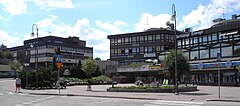Finspång
| |||
 | |||
| |||
| Państwo | |||
| Region | Östergötland | ||
| Gmina | Finspång | ||
| Powierzchnia | 7,88[1] km² | ||
| Populacja (2018) • liczba ludności • gęstość | 13 279[1] 1684[1] os./km² | ||
 | |||
| Strona internetowa | |||
| Portal | |||
Finspång – miejscowość (tätort) w południowej Szwecji w regionie Östergötland, siedziba gminy Finspång. Miasto położone jest 29 km na północny zachód od Norrköping.
Podstawą gospodarki miasta jest rozwinięty przemysł metalurgiczny (ABB Stal AB, Finspang Aluminium, Finspang Heat Transfer) o 300 letniej tradycji. Finspång jest także ważnym centrum kultury- znajduje się tu kilka kabaretów oraz muzeum kolejnictwa.
Przypisy
- ↑ a b c Statistiska tätorter 2018; befolkning, landareal, befolkningstäthet (szw.). Statistikmyndigheten SCB, 2020-03-20. [dostęp 2020-09-08]. [zarchiwizowane z tego adresu (2020-03-24)].
Media użyte na tej stronie
Autor: Erik Frohne, Licencja: CC BY 3.0
Location map of Östergötland County in Sweden
Equirectangular projection, N/S stretching 190 %. Geographic limits of the map:
- N: 59.10° N
- S: 57.60° N
- W: 14.20° E
- E: 17.20° E
Autor: Autor nie został podany w rozpoznawalny automatycznie sposób. Założono, że to Nordelch (w oparciu o szablon praw autorskich)., Licencja: CC BY-SA 2.5
Finspång Municipality in Östergötland County
- Designed by me.
- Mere outlines are a PD source from www.scb.se
(c) Lokal_Profil, CC BY-SA 2.5
This coat of arms was drawn based on its blazon which – being a written description – is free from copyright. Any illustration conforming with the blazon of the arms is considered to be heraldically correct. Thus several different artistic interpretations of the same coat of arms can exist. The design officially used by the armiger is likely protected by copyright, in which case it cannot be used here.
Individual representations of a coat of arms, drawn from a blazon, may have a copyright belonging to the artist, but are not necessarily derivative works.











